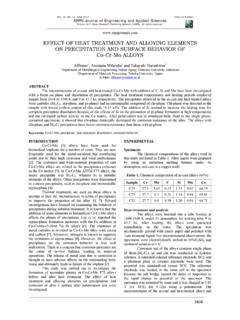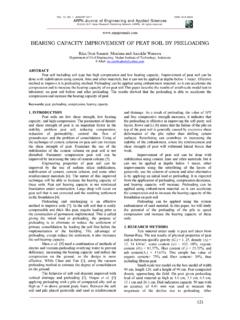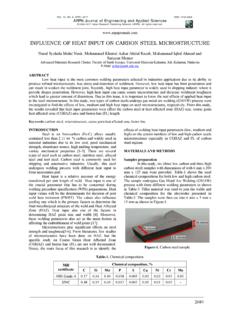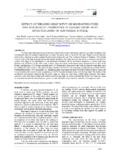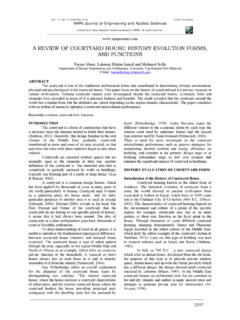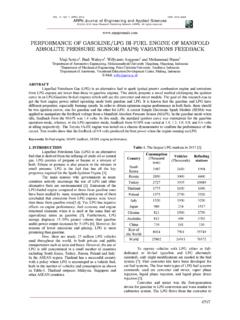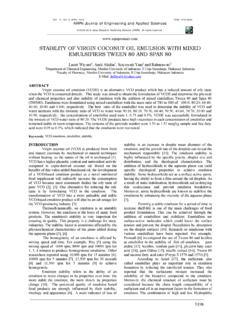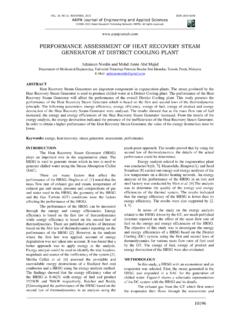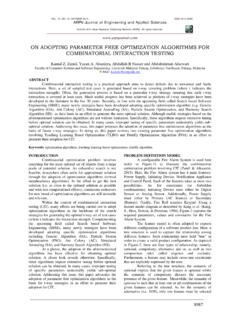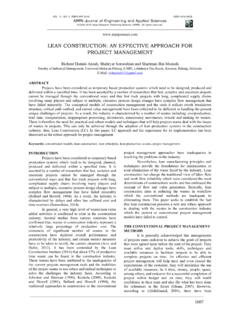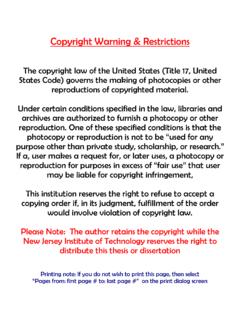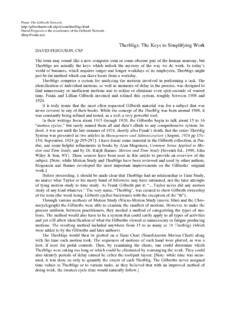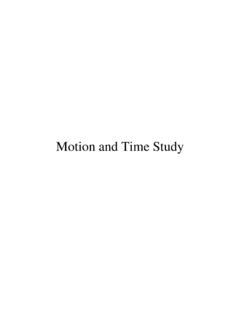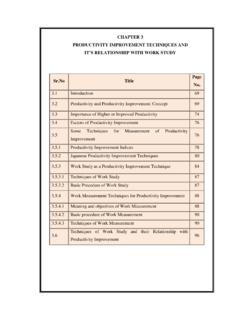Transcription of PRODUCTIVITY IMPROVEMENT USING TIME STUDY …
1 VOL. 11, NO. 1, JANUARY 2016 ISSN 1819-6608 ARPN Journal of Engineering and Applied Sciences 2006-2016 Asian Research Publishing Network (ARPN). All rights reserved. 666 PRODUCTIVITY IMPROVEMENT USING time STUDY ANALYSIS IN A SMALL SCALE SOLAR APPLIANCES INDUSTRY- A CASE STUDY A. Sai Nishanth Reddy, P. Srinath Rao and Rajyalakshmi G. School of Mechanical and Building Sciences, VIT University, Vellore, India E-Mail: ABSTRACT The pattern of economic competitiveness has changed globally now days. Many countries have joined the global economic competition to capture global market in order to remain profitable and competitive by increasing its PRODUCTIVITY .
2 There are many factors that influence the PRODUCTIVITY of a manufacturing organisation. The most widely tackled issue is how to improve efficiency and PRODUCTIVITY . motion and time STUDY technique is one of the PRODUCTIVITY IMPROVEMENT techniques used in many manufacturing companies. motion and time STUDY is defined as a scientific analysis method designed to determine the best way to execute the repetitive task and to measure the time spent by an average worker to complete a given task in a fixed workplace. In manufacturing industries, assembly line is also another major area to be taken into consideration for increasing PRODUCTIVITY . Throughout the STUDY , the aim is to propose a new system to the related company to increase their PRODUCTIVITY . The purpose of this paper is to discuss related issues of motion and time STUDY implementation and assembly line balancing and its influence toward PRODUCTIVITY IMPROVEMENT .
3 Data from a STUDY carried out on a sample of manufacturing industry small scale solar appliances shows that motion and time STUDY implementation and assembly line balancing contributes positively towards achieving PRODUCTIVITY . Keywords: PRODUCTIVITY IMPROVEMENT , manufacturing industries, assembly line balancing, motion and time STUDY analysis. INTRODUCTION Assembly lines are production systems developed to meet the requirements of mankind, which continue to grow day by day. The demand for greater product variability and shorter life cycles has caused traditional production methods to be replaced with assembly lines. The aims of these systems are to manufacture products at production rates in the shortest time , in the most productive way, cheaply and with the quality required. Since assembly line balancing is an NP-hard problem, some heuristic methods are still needed to solve large scale assembly line balancing problems.
4 Paul and Rabindra (2006) used subjective assessment through questionnaire, direct observation method, and archival data to improve PRODUCTIVITY , quality, increasing revenue and reducing rejection cost of the manual component. Brown and Mitchell (1998) investigated operators, engineers and managers of PCA (Printed circuit assembly) factories to determine the work environment parameters that inhibited their performance and they recommended opportunities to improve production and quality. Lim and Hoffmann (1997) found that improved layout of the workplace increased PRODUCTIVITY of the workers, through more economical use of hand movements by conducting an experiment on hacksaws assembly. Christopher (1998) stated that the success in any competitive context depends on having either a cost advantage or a value advantage, or, ideally both. ImadAlsyouf (2007) illustrated how an effective maintenance policy could influence the PRODUCTIVITY and profitability of a manufacturing process and showed how changes in the PRODUCTIVITY affect profit, separately from the effects of changes in the uncontrollable factors, price recovery.
5 Browning and Heath (2009) developed a revised framework that reconceptualises the effect of lean production costs and used it to develop eleven propositions to direct further research and illuminated how operations managers might control key variables to draw grater benefits from lean implementation. White et al. (1999) found that plant size had a significant effect on the implementation of lean practices. This shows that regardless of establishing what lean is, it remain important to establish how best to become lean in varied contexts. Shah and Ward (2003) empirically validated four bundles of inter related and internally consistent practices, these are just in time (JIT), total quality management (TQM), and human resource management and investigated their effects on operational performance. Flynn et al. (1995) and McKone et al. (2001) have explored the implementation and performance relationship with two aspects of lean.
6 Crute et al. (2003) discussed the key drivers for lean in aerospace and did a lean implementation case comparison which examines how difficulties that arise may have more to do with individual plant context and management than with sector specific factors. VOL. 11, NO. 1, JANUARY 2016 ISSN 1819-6608 ARPN Journal of Engineering and Applied Sciences 2006-2016 Asian Research Publishing Network (ARPN). All rights reserved. 667 Womack et al. (1990) developed from the massively successful Toyota Production system, focusing on the removal of all forms of waste from a system. Krafcik, (1998) describes the Japanese style manufacturing process pioneered by Toyota, which uses a range of techniques including JIT inventory systems, continuous IMPROVEMENT , and quality circles.
7 An assembly line consists of a number of workstations which are arranged along a conveyor belt, or similar material transportation equipment, in order to obtain a sequence of finished product types. The work pieces are moved from station to station and at each one certain operation are performed in view of some constraints. The first primary constraint is the cycle time . The cycle time is the time interval between finishing two units or the maximum available time for the production of any work piece at any workstation. Assembly line exists when we assemble or handle any device or product in a planned, sequential manner with two or more operators performing tasks of repetitive work at established workstation (Milas, 1990). When the products have many operations and the demand is high the process of balancing the line becomes more difficult. There are two types of optimization problems for the line-balancing problem (Ajenbit, 1998).
8 In Type I, the cycle- time is fixed and the objective is to minimize the required number of workstations. The Type II attempts to minimize the maximum cycle- time given a fixed number of workstations. This research paper will adopt the Type I problem. The overall objective of this paper is to improve PRODUCTIVITY through line balancing by minimizing both labor and idle times on the production line. This paper intends to investigate and evaluate the line balancing problem in a production line of Nano bright solar technologies. The aims of the STUDY are improving the PRODUCTIVITY and computing the efficiency of an assembly line in small and medium industry. The objectives are to re-design the layout for the purpose of improving the line performance. Computer aided simulation is implemented in this project in order to analyze and investigate the problems occurring in assembly line.
9 The line balancing method is use to solve the problem. Comparison of the current system and new system are done. Simulation is done by Arena software to accomplish this STUDY . CASE STUDY : CURRENT LAYOUT DESIGN The present system, the assembly line consists of 9 main activities. These 9 activities are completed in 4 workstations. Around 300 units are worked upon in a workstation. Only after all the 300 units undergo a particular operation, they are transported to the next workstation. This is how the assembling is done in the current system. In the original assembly method, the input buffer has no pre-specified capacity. The master boxes were piled at both input and output sides of the assembly table in stacks at a workstation USING storage pallets. The individual packages were then removed from the master box on to the table, all at a time , and the assembly is carried out on each package by four different operators.
10 The subassemblies and the headset components were pushed from one person to the next person on the table without an appropriate material handling arrangement. Once the assembly was completed, the packages were arranged in an empty master box and placed on storage pallet. The workstations in the present system are shown in Figure-1. Gooseneck gumming Connector insert, LED soldering LED PCB assembly, PCB screw fixing and battery fixing Battery testing, final assembly and packing The various activities carried out at each work station are presented in following flow charts. Activities in the first workstation are given in flow charts. VOL. 11, NO. 1, JANUARY 2016 ISSN 1819-6608 ARPN Journal of Engineering and Applied Sciences 2006-2016 Asian Research Publishing Network (ARPN).
